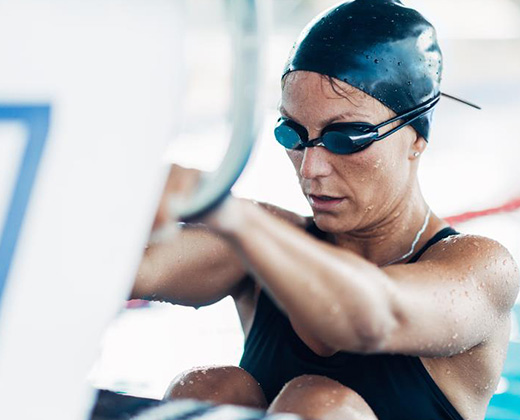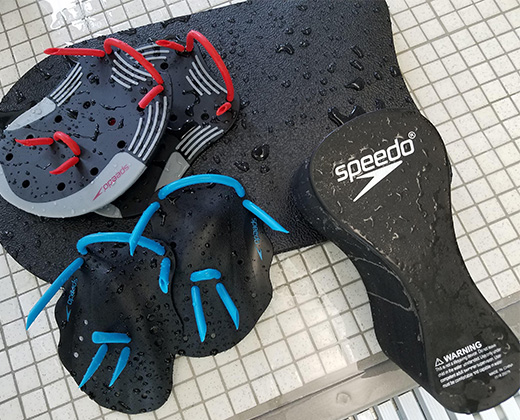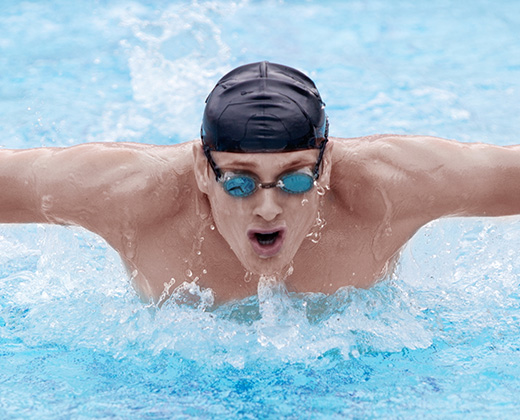Breaking Down the Butterfly Stroke Technique
Learn how to “float like a butterfly” with these Pro Tips on proper butterfly swimming technique.
Of the four competition strokes, the butterfly stroke may be the most difficult to master. This swimming style has three important components: arms, which move synchronously; legs, which employ a “dolphin” kick; and body, which should conduct a wave-like movement throughout the stroke. Division I swim coach Marc Christian shares his butterfly stroke tips to help you get moving in the water.
BUTTERFLY HEAD AND BODY POSITION
The wave-like motion of your body throughout the butterfly is called body undulation. Once you master this technique, it can also help your butterfly arm stroke, as well as your kick.
- Begin by floating on your chest with your body straight and arms extended forward.
- Your head should face down, looking toward the bottom of the pool.
- The wave should begin at your shoulders and move down to your hips, ultimately ending at your feet.
- At the point where your chest naturally rises, you will take a breath.
“Butterfly requires timing and strength, but also relaxation,” Christian says. “It is important to remain relaxed when swimming butterfly. It is essential to have a flow through your body undulations.”
BUTTERFLY ARMS AND HANDS POSITION
Begin with your arms extended and shoulder width apart. Your chest should be pushing down into the water. Next, move into the “catch” position, which creates your propulsion.
- Bend your arms at the elbow, this is the catch position.
- Pull your arms back and up through to your hips. At this point, your chest should press forward and raise your arms.
- Throw your arms outward, perpendicular to your body.
- Bring your arms up and over your head, ultimately ending in their initial starting position.
Remember to breathe as your arms are pushed behind you.
HOW TO BUTTERFLY KICK
“For every good butterflyer, you have a great butterfly kick,” Christian says. “We call that kick the dolphin kick. The dolphin kick is an extension of your body undulations that you start when you’re using your pull.”
BUTTERFLY KICK TECHNIQUE
The butterfly kick originates from your hips. This should also be the largest portion of the kick. Make sure you’re keeping your feet and legs together throughout the motion. Drive your hips down into the water and let your legs bend slightly at the knee. Your thighs should follow your hips downward while the lower portion of your legs rise. As your hips come up, straighten out your legs to execute a whipping motion.
You need to generate power from your hips and core muscles to extend the kick through to your legs and toes.
BUTTERFLY STROKE TIMING
When performing the butterfly stroke, you only get one pull to every two kicks. Therefore, it is important to understand when to take these kicks. The first kick should be taken as you begin your pull. Meanwhile, the second kick should be taken as your hands are coming through the catch position and about to exit near your hips.
The second kick should be a strong, small kick to help your arms recover forward.
BUTTERFLY DRILL
A helpful drill for learning how to swim butterfly is the “dolphin dive drill”. This training technique can help you work on your body undulation, as well as your kick.
The dolphin dive drill is completed by using a lane with two lane lines. You should push off the wall and try to kick from lane line to lane line. The goal is to find a strong flow that allows you to kick evenly to both sides.
With these tips, your butterfly stroke technique can be as smooth as butter. For more swim tips, check out our Pro Tips guides on the freestyle stroke and backstroke.








